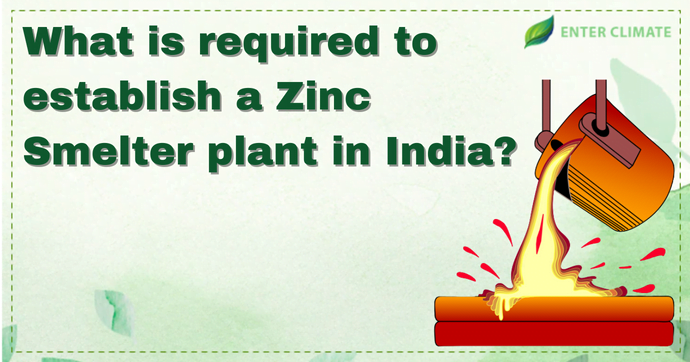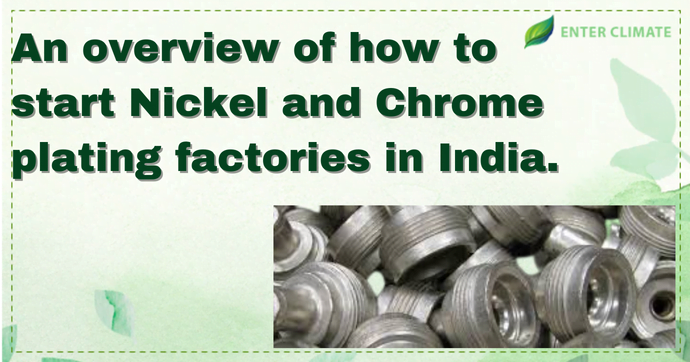What is required to establish a Zinc Smelter plant in India?
 21 Nov, 2022
21 Nov, 2022 
Zinc ores in India are concentrated in Rajasthan, and the biggest smelting plants are situated in the state. The smelting of zinc is a capital-intensive business and involves many stages between mining and the final product. As zinc and lead ores are often mixed, the mining and smelting of both metals are done at a zinc smelter plant. Imperial Smelting Process (ISP) is one of the most widely used smelting technologies, which smelts zinc and lead simultaneously. It consists of two sub-processes, lead-zinc sinter and imperial melting. The main products in zinc smelting are special high grade (SHG), prime western (PW) zinc and zinc continuous galvanising grade (CGG) zinc. But this can vary as per the composition of zinc ore. Zinc finds various uses in vital industries like steel production, die-casting, alloys, oxides and chemical industries etc. The Galvanising Industry alone consumes about 57% of zinc, followed by coatings (16%), die-casting alloys (14%), oxides & chemicals (7%) and extruded products (6%).
Process of Zinc Metal Production
The zinc concentrate that is mined from ores goes through several physical and chemical processing stages. The chemical reaction between coke and air produces heat to smelt the metallic oxide in the charge into the elemental metal. Molten lead falls at the bottom of the furnace, where it is tapped and sent for refining. As the temperature of operation is very high, zinc metal is formed as a vapour which is made to pass through a condenser. The vapour gets absorbed by lead and is cooled to separate zinc. The molten zinc is passed through a double distillation column for further refining, producing zinc as a significant product. In short, the metal is reduced through distillation (through pyrometallurgy) or electro-winning (through hydrometallurgy). It is important to note that the latter accounts for approximately 80% of total zinc refining. Cadmium is also produced in the process as a by-product.
Requirement for Zinc metal Plant
Apart from the obvious requirement like exhaustive market research, the demand for the product, proximity to the source of raw material, land for setting up the smelting plant and the required machinery and equipment, a zinc smelter plant will also need the following.
Mining Lease
If the smelter plant decides to lease the ore, it must obtain a mining lease from the state government. Minerals concession for major minerals is granted under the provisions of the Mines and Mineral (Development and Regulation) Act, 1957[1], Mineral Concession Rules, 1960 and The Mineral Conservation and Development Rules, 1988. For major minerals reconnaissance permits, prospecting licenses and mining leases are granted.
Industrial waste Management by Zinc Smelter Plant
The health hazards associated with a zinc smelter plant are exposure to ore dust during ore processing and smelting and metal fumes of zinc and lead emitted during the refining and roasting process. Other hazardous gases are also released, like sulphur dioxide and carbon monoxide.
- During leaching and zinc electro-winning, wastewater containing sulphuric acid is generated. Other waste from this process includes electrolytic cell slimes/sludge etc. This will require treatment and stabilisation of the waste.
- In metal pickling, used in the steel galvanising process, cations are removed with the help of hydrochloric acid in the form of complex anions. Such heavy metal ions must be separated from the water.
- In Zinc purification, contaminants such as sulphuric acid, iron etc., are present in wastewater. The other waste includes Copper cake, cadmium etc. Neutralising the acid and treating the wastewater is therefore essential.
- Ti foam used for filtration in ZnSO4 solutions in the process of zinc smelting is hazardous and has to be removed.
- The noise from the crushing and grinding of ore and the noise made from furnaces are other forms of pollution associated with the zinc smelter plants. Therefore means to reduce noise levels must also be implemented.
Licences and Authorisation Required by a Zinc Smelter Plant
Environmental Clearance for zinc mining and smelting: A proposal must be submitted to the Ministry of Environment, Forest and Climate Change (MoEF&CC) to prescribe a Terms of Reference (TOR) for undertaking a detailed EIA study for obtaining Environmental Clearance. The proponent must submit online information in the prescribed format (Form-1) along with a Pre-feasibility Report. The documents required in this regard are
- Detailed Project Description (the name of the project, proposed breakup of area, water requirement, waste generation, location etc.)
- Site/ Layout plan
- Proof of installed machinery
- Proof of Land Ownership
- ID proof of Signatory
- Quality test Report (wherever applicable)
- Proof of mitigation options adopted
- Proof of Electricity and water connection
Pollution NOC: Integrated Zinc Smelter plant is on the list of 17 Highly Polluting Industries identified by CPCB and has been placed in the Red category of Industries and generates hazardous industrial waste, effluents and air discharge in the process. Pollution NOC is issued to the smelter plant in 2 stages, i.e. Consent to Establish (CTE) and Consent to operate (CTO) mandated under Air Act and Water Act. The documents required at this stage include
Documents Required for CTE
- Duly-filled online Application Form
- Signed Undertaking
- Site Plan or layout plan
- Detailed Project Report
- Layout plan
- Details of finished products
- Details of the manufacturing process, including a list of machinery
- Land Ownership documents such as rent /lease agreement
- Industry Registration Proof
Documents required for CTO
- Duly filled Application form
- Balanced Sheet Certified by a CA
- Copy of CTE issued
- Details of air & water pollution control devices
- Copy of land-related documents
- Consent fee (as applicable)
- Laboratory analysis report of effluent and air emissions.
- Environmental Clearance
Other Licences Required Zinc Smelter Plant
- Authorisation for hazardous waste / solid waste.
- Water supply sanction and connection from ULBs
- CGWA NOC for Water Abstraction
- Factory Licence
- Fire NOC (No Objection Certificate)
- GST Registration.
Market Overview and Scope of Zinc Smelter Plants in India
The country’s five largest zinc mines are in Rajasthan, namely Rampura Agucha Mine, Zawar Mine, Sindesar Khurd Mine, Kayak Mine, and Rajpura Dariba Mine. The region cumulatively produced approximately 656.6 thousand tonnes of zinc. The production of lead and zinc ore at 13.75 million tonnes in 2018-19 increased by 9% compared to the previous year. Almost all zinc production is being reported from Rajasthan due to the concentration of zinc ores in the region. This, however, presents an opportunity for new smelting plants in the area and the adjoining states. As zinc concentration in the ores is decent in the ores present in the region, the profitability of zinc smelter plants also increases. The demand for zinc is increasing daily and is being fulfilled by only a few private players in the segment. Extraction from the primary source (zinc ores), as well as secondary refining of zinc-containing alloys and metals, can be done by a zinc smelter plant. The demand for secondary zinc has also shown a rise due to its applicability in industries like the iron and steel industry and the oxide and chemical industry.
Conclusion
As per popular research on the smelting process, hydrometallurgical zinc smelting has shown to have additional advantages over the pyrometallurgical process. Any zinc smelter plant must try to incorporate eco-friendly methods into smelting that are proven to be energy efficient and sustainable. Besides, the growing market share of primary, as well as secondary zinc obtained through domestic smelting has demonstrated the potential of the zinc smelting industry and the need to boost the refining capacity in light of increasing demand. Smelter Plant, however, requires a lot of procedural formalities due to their polluting potential and, therefore, a lot of challenges in the licencing and authorisation process. Expert assistance can ease the setup process and fulfil the legal formalities associated with zinc smelter plants.
Read our Article: Complete the process to establish a Copper Smelter business
Categories
Latest Post
Air pollution Dispersion Modeling
Natural Disaster Risk Assessment
Endangered Species Protection
Aquifer Recharge Project
Sustainable Sanitation Solutions














